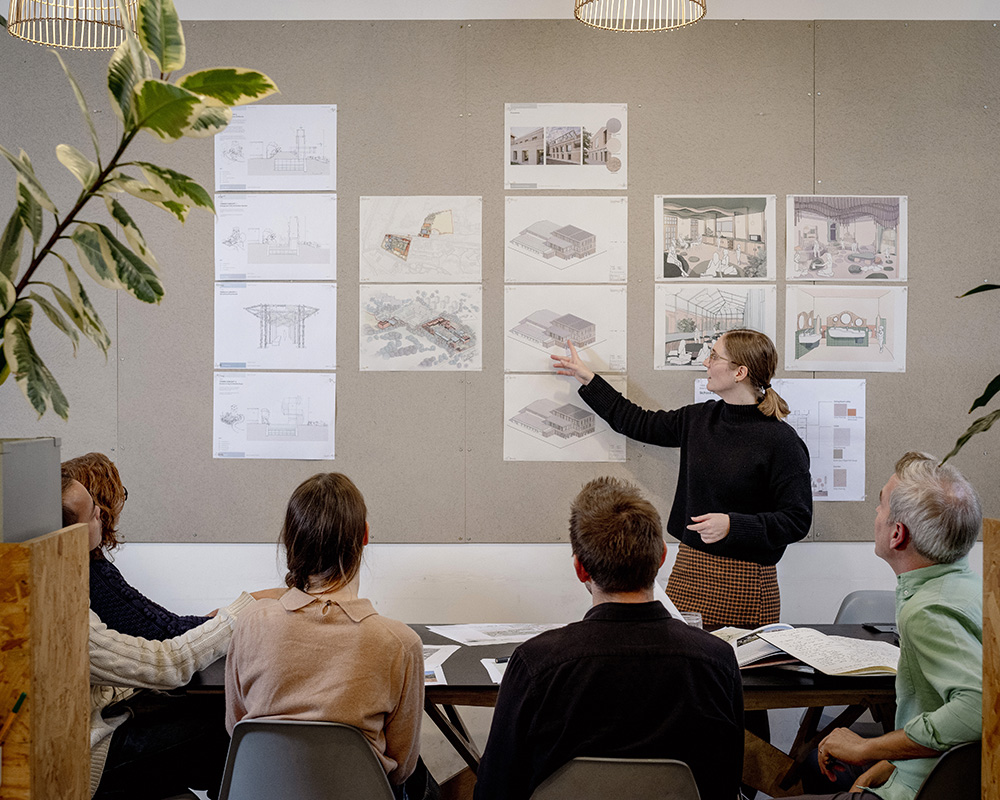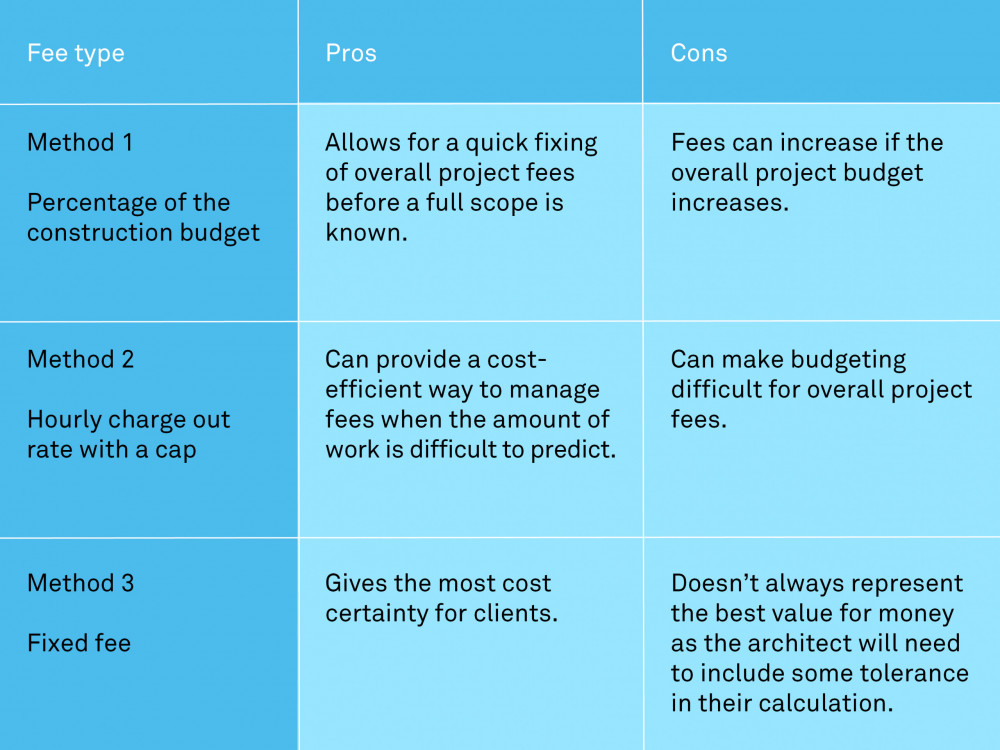
We have written this article to provide some insight as to how architects calculate their fees and what affects the amount they charge. It’s important to say from the outset that this article is based on Tate + Co’s experience of calculating our fees and other architects may do things in a slightly different way.
The first thing to mention is that we tailor all our fees for each project individually, and so generally there isn’t a ‘standard rate’ that we would use for a producing work for a planning application for example.
Three common calculation methods
There are essentially three ways that architects calculate the fees for their work, and the option chosen will depend on the type and scale of the project and will often be based on the preference of the client commissioning the work.
Method 1: Percentage of the construction budget
This is perhaps the most well-known method of fee calculation, and historically was the most common. With this option, the architect would take the overall construction budget agreed with you as the client for the project. They would then apply a percentage rate depending on the type of project and scope of service required.
As an example. If you agreed a £5,000,000 construction budget for the project then the architect might charge a percentage of 7% of this as their overall fee for the project (giving an overall fee of £350,000, although as the percentage is fixed, this fee would go up or down if the construction budget increased or decreased). The architect would normally then give you a breakdown of how much they will charge at each RIBA work stage.
This option is simple to understand and makes sure that if the project expands in scale the architect’s fees will increase to cover the increased scope needed. It also allows for a quick fixing of fees against a budget before the exact scope of the project is known.
The problem with this method, however, is that the size and complexity of the project isn’t directly related to its budget and so it can lead to a misalignment of fees against the scope needed. For example, if you were to choose a more expensive flooring throughout a building this doesn’t necessarily mean any more work for the architect but would increase the budget and therefore their fee. Likewise, if a building was to grow in size, and at the same time the internal finishes were to become less expensive this could mean a lot more work for an architect but no additional fees to cover this.
The other problem with this calculation method is that clients perceive it as an incentivising the architect to push for greater construction costs as part of the design process. The honest answer to this is that one of our duties as an architect is to manage predicted construction costs, and it therefore should not be possible for these costs, and therefore our percentage fee, to increase without prior agreement.
Method 2: Hourly charge out rate with a cap
This option is another commonly used method and can be very useful when the scope of service needed is slightly unclear. It works in a similar way to how you might commission a lawyer. Your architect would estimate how many hours they will need to spend to complete the project and gives you a budget accordingly. They then record the number of hours they have worked and charge you for them. However, if they reach the agreed budget and need to exceed it to complete the work, then you would need to pay for the additional time against their charge-out rate.
As an example, you might know that you need an architect to prepare and submit a Listed Building Application, but it might be difficult to predict exactly how many meetings with the council might be needed. In this example you could consider this fee option.
This fee allows you to make sure that you’re only paying for the exact time that you need from your architect and no more. As a result, this option is often the most cost effective. The difficulty, however, is that it makes it hard for you to budget how much you might need to pay the architect to complete the job.
Method 3: Fixed fee
The third option is by far the most common method of fee payment that we see being used in the industry today. The architect essentially estimates how many hours of their time will be needed to complete the required scope. This is then multiplied against an hourly rate to give an overall fee calculated against a scope of service. The difference vs Method 2 is that this fee is then fixed, and if the scope of service doesn’t change then the architect’s fee should not alter, even if it takes them longer to complete the work than they had estimated.
At Tate + Co we use a software called CMAP which assists us to accurately record how long it has taken us to complete each stage of the project. We use this to assist in our estimation of the hours required to complete a project scope. This allows us to make sure that we can always provide the right level of service against a clear scope and provide an accurate fixed fee.
The benefit of this option is that you will have, as the name implies, a ‘fixed fee’ that will not change unless the scope of service changes. It allows you to budget more accurately how much your overall project is likely to cost you. Your architect will, however, be fixing their costs against the estimated time they will need to spend on your project and so they will need to include some tolerance within their calculation.
Benchmarking
When we calculate our fees, we will always calculate the amount of time it will take us to complete the project and use this to make sure we can give enough resource to the project.
To make sure that we are competitive, we also benchmark our fees against the Architect’s Fees Bureau, which is compiled from an industry-wide annual survey.
Factors that may cause changes to the agreed fee
If you have chosen Method 3, you may assume that this means that the fee is fixed and that it will never change. There are, however, three factors to bear in mind which can increase (or decrease) the fee during the project.
Project scope: If the scope of the project changes from what you have agreed in your brief, then this might impact the architect’s fees. They might need to change their design to accommodate the change, or it might mean more drawings need to be produced to cover the new parts of the project.
Design scope: If more information is needed than you have agreed at the outset, when the fee was calculated, this might increase the architect’s fees. For example, the planning feedback you receive might ask for specific additional drawings to be produced that neither you nor your architect could predict.
Project programme: If the timescale for the project completion extends then it might be that your architect will ask for their fee to be increased to accommodate this. They may still need to attend site on a weekly basis to oversee construction throughout this time extension or attend a weekly meeting if a planning deadline is extended.
What is the right fee option for you?
In summary, there is no right answer as to how to calculate an architectural fee and each of the three methods listed above have their advantages and disadvantages. The method you choose should be based on what the most critical factors are for your project. It’s also possible to use a combination of the above for different stages as a project develops to tailor the fee to suit your specific needs.
Laurence Pinnfire
Director

Laurence joined Tate+Co in 2011. He is design-led yet blends this with a practical understanding of development to ensure concepts can become a reality. Laurence has been the project architect for many significant projects at the practice including the Eden Canopy Walkway and the Brunel Museum Reinvented project, re-opening Isambard Kingdom Brunel’s first ever structure for use as a performance space.
Laurence graduated from Nottingham University with first class honours and received a distinction for his Part II at Westminster University before completing his Part III certificate at RIBA Northwest. He has previous experience working in a number of other London based practices including Hopkins Architects, where his work included a residential project for Rice University, Texas.
Laurence has a particular interest in regenerative design and has taken part in talks and written articles on the subject. In 2015, Laurence was awarded the AKT II Architecture prize at the Royal Academy Summer Exhibition for his Urban Floral Propagation field box.

